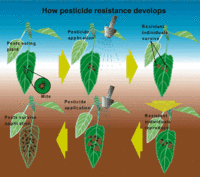-
Killing superbugs dead with “molecular drill bits”
Tuberculosis (TB) is a well-known, treatable disease, but resistant strains are cropping up. The World Health Organization (WHO) estimates that about 170,000 people died from multidrug-resistant TB in 2012. In response to drug-resistant “superbugs” that send millions of people to hospitals around the world, scientists are building tiny “molecular drill bits” which kill bacteria by bursting through their protective cell walls.
-
-
Faster anthrax detection could speed bioterror response
The fall 2011 anthrax attacks cost $3.2 million in cleanup and decontamination. At the time, no testing system was in place that officials could use to screen the letters. Currently, first responders have tests that can provide a screen for dangerous materials in about 24-48 hours. Now, researchers have developed a new method for anthrax detection that can identify anthrax in only a few hours.
-
-
Positive safety results Marburg drug candidate announced
Marburg hemorrhagic fever is a severe and potentially fatal disease in humans first recognized in 1967. It is caused by an RNA virus of the Filoviridae family and is understood to be endemic to Africa. The Marburg virus is classified as a Category A bioterrorism agent by the Centers for Disease Control and Prevention (CDC), and in 2006 was determined by DHS to be a material threat to national security and public health. There are currently no treatments for Marburg virus infection beyond supportive care. Cambridge, Massachusetts-based Sarepta Therapeutics, a developer of innovative RNA-based therapeutics, announced positive safety results from a Phase I multiple ascending dose study of AVI-7288 in healthy volunteers. AVI-7288 is the company’s lead drug candidate for the treatment of Marburg virus infection.
-
-
25 children in California stricken with polio-like illness
Twenty-five children in California have been exhibiting a “polio-like syndrome,” leading to paralysis in one or more of their limbs. “What’s we’re seeing now is bad. The best-case scenario is complete loss of one limb, the worst is all four limbs, with respiratory insufficiency, as well. It’s like the old polio,” say a a pediatric neurologist. Scientists say that samples from two of the children tested positive for enterovirus 68, a rare virus linked in the past to severe respiratory illness.
-
-
Visually displayed early warning system for epidemics
Cholera has been all but eradicated in Europe, but this bacterial, primarily waterborne disease still claims thousands of lives in Africa every year. In an EU-funded project, scientists are examining the effects various environmental factors have on cholera epidemics in Uganda, and have developed a software architecture for early warning systems that compares environmental and health data and presents the results graphically, allowing for the creation of visually displayed early warnings of epidemic breakouts.
-
-
Uncovering drug resistance mechanism to help development of antibiotic drug candidates
The use of antibiotics is often considered among the most important advances in the treatment of human disease. Unfortunately, though, bacteria are finding ways to make a comeback. More than two million people in the United States come down with antibiotic-resistant infections annually, and at least 23,000 die because their treatment cannot stop the infection. A new study has uncovered a mechanism of drug resistance. This knowledge could have a major impact on the development of a pair of highly potent new antibiotic drug candidates.
-
-
Superbugs presence increases during annual pilgrimage to India’s sacred sites

The spread of antibiotic-resistance to one of the most pristine locations in Asia is linked to the annual human pilgrimages to the region, new research has shown. The researchers have found that in May and June, when hundreds of thousands of visitors travel to Rishikesh and Haridwar to visit sacred sites, levels of resistance genes that lead to “superbugs” were found to be about sixty times greater than other times of the year. They argue that preventing the spread of resistance genes that promote life-threating bacteria could be achieved by improving waste management at key pilgrimage sites.
-
-
Solution to drug resistance problem receives U.S. patent
Before the development of penicillin, people dropped like flies in response to minor infections. Even pimples could grow to boils that killed. One of the main killers prior to the discovery of antibiotics was tuberculosis. The deadly infectious disease that typically affects the lungs has returned – and has developed a resistance to the majority of antibiotics that would otherwise kill the tuberculosis bacteria. A Danish chemistry researcher has taken out a patent for a drug that can make previously multidrug-resistant bacteria once again responsive to antibiotics.
-
-
Gaining better understanding of tularemia, aka “rabbit fever”
Tularemia, aka “rabbit fever,” is endemic in the northeastern United States, and is considered to be a significant risk to biosecurity — much like anthrax or smallpox — because it has already been weaponized in various regions of the world. Despite its importance for both public health and biodefense, F. tularensis pathogenesis is not entirely understood, nor is it fully understood how the organism persists in the environment.
-
-
Resistance shapes the discovery of new insecticides

Recent news around the world has focused on the dangers of antibiotic resistance. – and the CDC estimates over two-million illnesses and 23,000 deaths occurred in 2013 as a result of antibiotic resistance in bacteria and fungus. But what of another type of resistance which can also have a huge impact on the population: that to insecticides? Livestock, for example, are affected by buffalo flies; farmers and customers are familiar with the total devastation caused by fruit flies; malaria mosquitoes and bed bugs are becoming more resistant to existing chemicals. Even our pets are affected: fleas and ticks are continuing their march, leading to a need for newer, often more expensive synthetic chemistries. The price of insecticide resistance — in the form of R&D costs for new compounds — is passed from chemical companies, to farmers, to consumers.
-
-
North Carolina brain surgery patients exposed to deadly disease
Officials at a North Carolina hospital last Tuesday notified eighteen patients that they might have been exposed to Creutzfeldt-Jakob disease (CJD), a degenerative brain disease which is always fatal and which makes those infected exhibit symptoms of dementia before they die. The eighteen patients had brain surgery performed on them since 18 January. A patient operated on that that day was subsequently tested positive for the disease. The hospital said that the surgical instruments used on the patient with CJD were sterilized, but were “not subjected to enhanced sterilization procedures.’
-
-
HHS to fund development of drug for bioterrorism, antimicrobial-resistant infections
HHS says that a public-private is partnership will advance the development of Carbavance, a new option to treat bioterrorism threats and antibiotic-resistant infections. The two bioterrorism Carbavance will address are melioidosis, also known as Whitmore’s disease, and glanders. Both melioidosis and glanders can become resistant to existing antibiotics. Already, with existing antibiotic treatments, approximately 40 percent of people who become ill from these bacteria die from the illness, and up to 90 percent die if not treated.
-
-
FDA says voluntary phasing out of antibiotics in livestock is working
A study by the Natural Resources Defense Council(NRDC) says that the U.S. Food and Drug Administration allowed eighteen animal drugs to remain on the market despite the agency’s discovery that the drugs posed a high risk of exposing humans to antibiotic-resistant bacteria through food supply. The NRDC criticizes the FDA’s voluntary guidelines for antibiotic phase-out, but observers note that beginning in 2001, the FDA began reviewing thirty approved antibiotic-based feed additives, and that only a few – fewer than the eighteen claimed by NRDC – are still in use, and they, too, will soon be relabeled and not allowed for use in livestock.
-
-
Genes of Gypsies show traces of convergent evolution in response to Black Death
The Black Death once exterminated up to 30-50 percent of Europeans. Researchers have identified immune system genes in Europeans and Gypsies that likely underwent convergent evolution during Europe’s deadly epidemics. Immune system genes evolve under the influence of infectious diseases, but few studies have attempted genome-wide assessments of infection-driven evolution.
-
-
Oregon man infected with the plague leaves ICU
Paul Gaylord, a welder from Prineville in rural Oregon, who in July 2012 contracted bubonic plague from a stray cat, has recovered and can now reflect on his experience. After admission to the hospital, Gaylord lapsed into a coma for twenty-seven days. While in a coma, his hands and legs swelled and turned black. The doctors told him that tests showed he was infected with the bubonic plague, and that his fingers would have to be amputated.
-
- All
- Regional
- Water
- Biometrics
- Borders/Immig
- Business
- Cybersecurity
- Detection
- Disasters
- Government
- Infrastructure
- International
- Public health
- Public Safety
- Communication interoperabillity
- Emergency services
- Emergency medical services
- Fire
- First response
- IEDs
- Law Enforcement
- Law Enforcement Technology
- Military technology
- Nonlethal weapons
- Nuclear weapons
- Personal protection equipment
- Police
- Notification /alert systems
- Situational awareness
- Weapons systems
- Sci-Tech
- Sector Reports
- Surveillance
- Transportation
Advertising & Marketing: advertise@newswirepubs.com
Editorial: editor@newswirepubs.com
General: info@newswirepubs.com
2010-2011 © News Wire Publications, LLC News Wire Publications, LLC
220 Old Country Road | Suite 200 | Mineola | New York | 11501
Permissions and Policies
Editorial: editor@newswirepubs.com
General: info@newswirepubs.com
2010-2011 © News Wire Publications, LLC News Wire Publications, LLC
220 Old Country Road | Suite 200 | Mineola | New York | 11501
Permissions and Policies
